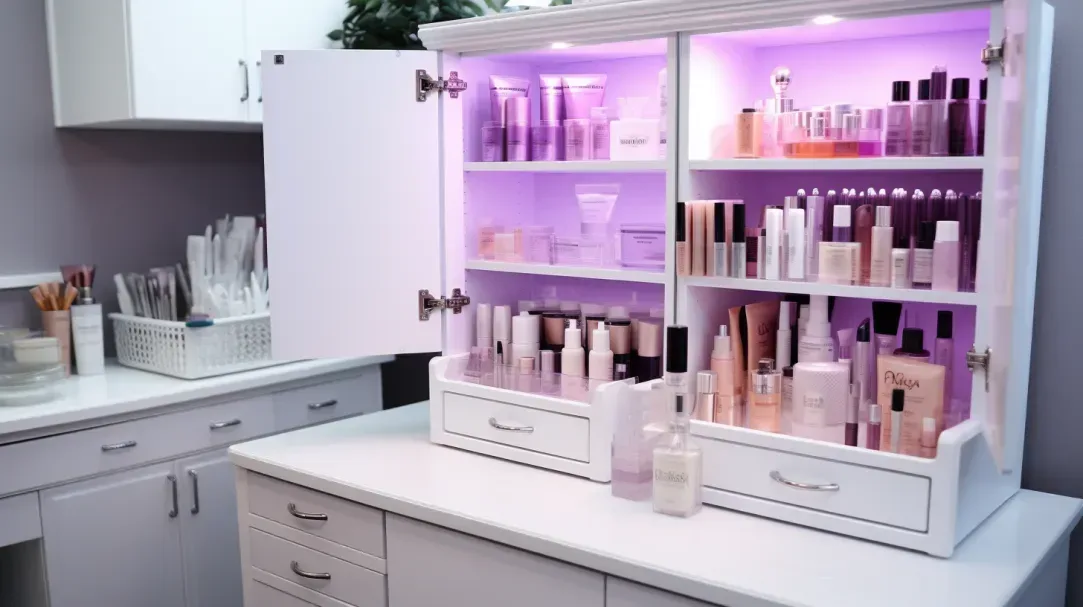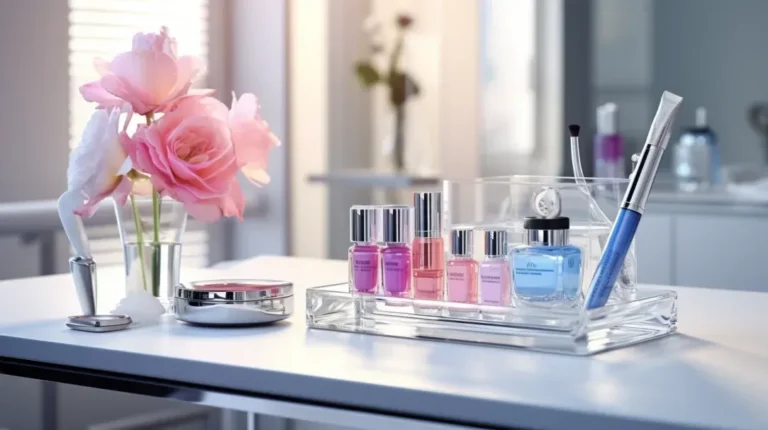Botox Reconstitution & Storage Recommendations
Are you looking for the ultimate guide to Botox reconstitution and storage? Well, buckle up because we’ve got you covered!
In this article, we’ll walk you through the best practices and techniques to ensure the potency and safety of your Botox treatments. We’ll cover everything from the impact of different saline volumes to the importance of proper storage temperature.
So get ready to dive into the key Botox storage and reconstitution recommendations.
Let’s make sure your patients get the best results possible!
Key Takeaways
- Precision dosage and patient-customized treatments are becoming increasingly crucial in Botox administration.
- Patient education and awareness about reconstitution and storage stability lead to more transparent practices.
- Technological integration in storage equipment and temperature monitoring is gaining traction to ensure the optimal potency and safety of Botox.
- Emphasizing patient safety and product efficacy remains central to industry best practices in medical aesthetics and pharmaceutical care.
Botox Reconstitution Process
To achieve the best results and ensure safety, it’s imperative to adhere strictly to the recommended procedures for Botox reconstitution. The techniques for reconstituting Botox and the practices for its dilution are critical in preserving both the effectiveness and safety of the product.
Key to the reconstitution process is using the correct quantity of diluent, typically sterile saline—the exact proportion of Botox to the diluent hinges on the required concentration for the intended use.
A sterile syringe and needle are essential tools for withdrawing the appropriate diluent. This is then carefully injected into the Botox vial. A gentle swirling motion should be employed to mix the Botox with the diluent, avoiding any vigorous shaking that could potentially damage the product’s integrity.
It’s crucial to use Botox immediately after reconstitution and to dispose of any unused solution. Adherence to these guidelines ensures the highest level of efficacy and dramatically reduces the likelihood of any adverse effects. This meticulous approach to Botox reconstitution is a cornerstone in achieving optimal outcomes and maintaining patient safety.
Recommended Saline Volume for Reconstitution
When considering the optimal reconstitution of Botox, it is crucial to determine the appropriate saline volume for achieving the desired concentration. Mixing Botox with saline allows for safe reconstitution and ensures the product’s potency. The recommended saline volume may vary depending on the concentration desired by the practitioner. To help you understand the saline volumes commonly used for Botox reconstitution, refer to the table below:
Desired Botox Concentration Saline Volume (in mL)
| Desired Botox Concentration | Saline Volume (in mL) |
|---|---|
| 1 unit/mL | 2.5 mL |
| 2 units/mL | 1.25 mL |
| 4 units/mL | 0.625 mL |
| 5 units/mL | 0.5 mL |
| 10 units/mL | 0.25 mL |
Proper Storage Temperature for Botox
Maintaining the potency and effectiveness of Botox requires careful adherence to specific storage conditions. The ideal temperature range for storing Botox is between 2°C and 8°C (36°F and 46°F). Keeping Botox within this temperature range ensures its stability and prolongs its shelf life.
It is essential to avoid freezing Botox. Exposure to freezing temperatures can significantly reduce its potency and effectiveness. Similarly, fluctuations in temperature should be avoided as they can adversely affect the integrity of the product.
When storing Botox, protecting it from direct exposure to light and heat sources is essential. Adhering to these storage recommendations is crucial in ensuring that Botox retains its potency and effectiveness throughout its intended shelf life, guaranteeing the best possible outcomes for its use.
Factors Affecting Botox Potency
The effectiveness of Botox treatments is contingent upon several critical factors related to its storage and handling. Understanding and adhering to these factors is crucial to ensure the treatment’s efficacy and safety.
- Impact of Storage Temperature:
- Optimal Temperature Range: Botox should be stored in a refrigerator, typically between 2°C and 8°C (36°F and 46°F). This range is critical to maintain the neurotoxin’s stability and potency.
- Avoiding Temperature Fluctuations: Consistent storage temperature is essential. Fluctuations can lead to the degradation of Botox, diminishing its effectiveness.
- Freezing Concerns: Freezing Botox is detrimental to its structure and efficacy. It’s crucial to ensure that storage conditions do not expose the vials to freezing temperatures.
- Preventing Contamination During Reconstitution:
- Sterile Techniques: Employing sterile techniques during the reconstitution process is paramount. This includes using sterile equipment and maintaining a clean environment.
- Handling Precautions: Care should be taken to avoid touching the vial’s rubber stopper and to use each vial for a single treatment session to prevent contamination.
- Timely Usage: Botox should be used within a specific timeframe to ensure potency once reconstituted. Following manufacturer guidelines for usage post-reconstitution is essential.
- Risks of Improper Storage:
- Reduced Efficacy: Improper storage can decrease the Botox treatment’s effectiveness. This includes potential risks from exposure to unsuitable temperatures or light.
- Safety Concerns: Improperly stored Botox may pose safety risks if it becomes contaminated or its composition is altered.
- Patient Satisfaction: The overall success of the treatment in terms of patient satisfaction and desired outcomes heavily relies on proper storage and handling of Botox.
In summary, the potency and safety of Botox are heavily influenced by storage conditions, handling practices, and adherence to recommended guidelines for reconstitution and usage. Healthcare providers administering Botox must be diligent in these aspects to ensure their patients’ maximum efficacy and safety.
Best Practices for Botox Storage
Proper storage practices are essential to ensuring the longevity and potency of Botox.
Following botox storage guidelines and recommendations for reconstitution is crucial to maintain the product’s effectiveness.
To begin, storing Botox in a refrigerator at a temperature between 2-8°C (36-46°F) is recommended. This temperature range helps preserve the stability and potency of the product. Additionally, it’s essential to protect the Botox vials from light and freezing temperatures.
When reconstituting Botox, it’s advised to use a sterile saline solution and follow the manufacturer’s instructions for the proper dilution. Proper handling procedures, including sterile syringes and needles, should be followed to prevent contamination.
Adhering to these best practices will help ensure the quality and effectiveness of Botox throughout its shelf life.
Preventing Contamination During Reconstitution
To prevent contamination during reconstitution, following strict sterile procedures and handling Botox with utmost care is crucial. Here are three essential steps to ensure sterility in Botox preparation and proper Botox handling procedures:
- Clean and disinfect: Before starting the reconstitution process, clean the work area thoroughly and disinfect all surfaces and equipment to eliminate any potential sources of contamination.
- Use sterile materials: Only sterile syringes, needles, and vials when reconstituting Botox. Ensure that the saline solution used for dilution is also sterile and impurities-free.
- Maintain aseptic technique: Throughout the reconstitution process, maintain aseptic technique by wearing sterile gloves and using sterile techniques when handling Botox. Avoid touching the vial’s rubber stopper with bare hands or non-sterile objects.
Risks of Improper Botox Storage
Improper storage of Botox can have significant risks, affecting both its efficacy and safety.
Temperature plays a crucial role in maintaining the potency of Botox, as deviations from recommended storage conditions can lead to decreased effectiveness.
Additionally, improper storage can increase the risk of contamination, compromising patient safety.
Temperature Impact on Efficacy
Storing Botox at the appropriate temperature is crucial for maintaining its efficacy and preventing potential risks. Here are three critical factors to consider regarding the temperature impact on Botox efficacy:
- Temperature fluctuations can degrade the potency of Botox: Exposure to extreme heat or cold can affect the stability of the botulinum toxin, leading to a decrease in its effectiveness. It’s essential to store Botox within the recommended temperature range to ensure optimal potency.
- Improper storage can compromise the results of Botox treatments: If it is stored correctly, its efficacy may be maintained, resulting in subpar patient results. Following proper storage guidelines ensures Botox maintains its efficacy and delivers the desired outcomes.
- Inadequate temperature control can increase the risk of adverse reactions: Fluctuations in temperature can increase the risk of contamination or bacterial growth in Botox vials. This can lead to adverse reactions when administering the product. Adhering to temperature guidelines is essential to minimize the risk of complications and ensure patient safety.
Contamination Risks During Storage
When storing Botox, it’s essential to be aware of contamination risks during improper storage. Following proper Botox storage guidelines is crucial to maintain the integrity and safety of the product. Improper storage can lead to contamination, compromising the effectiveness and safety of the Botox injections.
Contamination can occur due to air, moisture, or improper handling exposure. It’s essential to store Botox in a clean and controlled environment, away from direct sunlight and at the recommended temperature.
Additionally, proper hygiene practices should be followed during the reconstitution and storage process to minimize the risk of contamination. By adhering to the recommended guidelines, you can ensure the potency and safety of the Botox and minimize the risk of contamination.
Shelf Life of Reconstituted Botox
You can maximize the longevity of reconstituted Botox by adhering to proper storage guidelines. The shelf life of reconstituted Botox vials depends on several factors that affect their stability.
Here are three essential factors to consider:
- Storage temperature: Botox should be stored in a refrigerator at a temperature between 2°C and 8°C (36°F and 46°F). Maintaining a consistent and cool temperature helps preserve the potency of the reconstituted Botox.
- Protection from light: Botox is sensitive to light and should be stored in its original packaging or a light-resistant container. Exposure to light can degrade the product and reduce its effectiveness.
- Time since reconstitution: Reconstituted Botox should be used within 24 hours of mixing with saline. After this time, the potency of Botox may decrease, and its effectiveness may be compromised.
Importance of Temperature Monitoring
To ensure the optimal shelf life of reconstituted Botox, closely monitoring the temperature during storage is crucial. Temperature monitoring plays a vital role in maintaining the potency and efficacy of Botox.
The recommended storage temperature for Botox is between 2°C and 8°C (36°F and 46°F). Deviations from this temperature range can compromise the integrity of the product and affect its effectiveness.
It’s essential to regularly check the temperature in the storage area and ensure it remains within the specified range. This can be done using temperature monitoring devices such as thermometers or data loggers.
Safe Handling and Administration of Botox
Ensure the safe handling and administration of Botox by following proper protocols and guidelines. To maintain patient safety and achieve optimal results, it’s crucial to adhere to botox preparation guidelines and practice safe practices in botox administration. Here are three essential aspects to consider:
- Proper reconstitution: Follow the recommended guidelines for diluting Botox with saline. Use the appropriate volume of saline to achieve the desired concentration and ensure accurate dosage calculations.
- Sterile technique: Maintain strict aseptic techniques during reconstitution to prevent contamination. Use sterile syringes and needles, and discard unused or expired Botox vials according to disposal methods.
- Injection technique: Familiarize yourself with the correct injection sites and depths for different aesthetic indications. Ensure precise placement and use appropriate injection techniques to minimize the risk of adverse events.
Disposal Methods for Botox Vials
Proper disposal of used Botox vials is crucial to ensure environmental safety and compliance with medical waste regulations. Here are the recommended practices for disposing of Botox vials:
- Understanding Local Regulations:
- Consult Local Guidelines: Different regions have specific regulations regarding medical waste disposal. It’s essential to familiarize yourself with and adhere to these local guidelines.
- Medical Waste Management: Typically, used Botox vials are classified as medical waste and should be handled accordingly.
- Labeling and Separation:
- Label as Medical Waste: Clearly label the vials as medical waste to avoid any potential confusion or improper handling.
- Separate from Regular Trash: Used Botox vials should never be disposed of with regular garbage. They should be segregated to ensure they are processed as medical waste.
- Using Appropriate Containers:
- Puncture-Resistant Containers: Use puncture-resistant containers to minimize the risk of injury and contamination for any associated sharps, such as needles or syringes.
- Sharps Containers: Utilize approved sharps disposal containers for used needles and syringes. These containers are specifically designed to contain and store sharps waste safely.
- Safe Handling Procedures:
- Handling Precautions: When disposing of Botox vials, wear appropriate protective gear, such as gloves, to avoid direct contact with the vials and any residual contents.
- No Recapping of Needles: Do not recap needles before disposal to prevent needle-stick injuries.
- Disposal Services:
- Professional Medical Waste Disposal Services: Consider utilizing professional medical waste disposal services equipped to handle and process this type of waste safely and in compliance with regulations.
- Environmental Considerations:
- Avoid Flushing or Pouring Down Drains: Do not flush Botox or pour it down drains, as this can have harmful environmental impacts.
Cervical Dystonia Treatment with Botulinum Toxin
Cervical dystonia is a neurological condition that can lead to muscle weakness and pain in the neck. It often requires treatment with botulinum toxin type A, which is administered through safe injection techniques. The preparation, storage, and reconstitution of botulinum toxin are crucial, with specific hours and storage conditions to ensure its effectiveness. Clinical studies and research published in journals like “Dermatol Surg” have contributed to understanding the treatment’s effects and potential adverse reactions.
Recovery from muscle paralysis induced by botulinum toxin can vary among patients, and it’s essential to monitor muscle weakness and any paralysis rates. In some cases, adjacent muscles, such as the auricular or calf, may be affected, leading to specific challenges. However, the treatment is typically administered in single-patient use vials, and unopened vials must be handled with care.
The treatment of cervical dystonia often involves previous treatment history, and commercial preparations from companies like Medicis and Merz are commonly used. Medical professionals and advisory boards play a critical role in determining the appropriate treatment plan for each patient, with funding sources supporting research and access to this essential medical intervention.
Frequently Asked Questions
Are There Any Specific Guidelines for Reconstituting Botox With a Solution Other Than Saline?
There are guidelines for reconstituting Botox with a solution different from saline. It’s essential to follow specific instructions provided by healthcare professionals to ensure the safety and effectiveness of the procedure.
Can Botox Potency Be Affected if It Is Stored in a Refrigerator With Other Medications?
Storing Botox in a refrigerator with other medications can affect its potency. It is essential to follow proper storage recommendations to ensure the effectiveness of the medication.
What Factors Can Decrease the Potency of Reconstituted Botox Over Time?
Factors such as improper storage conditions, exposure to light, and reconstitution with incorrect diluent can decrease the potency of reconstituted Botox over time. Following proper storage and reconstitution guidelines is essential to maintain its effectiveness.
Are There Any Specific Storage Conditions or Containers That Should Be Used to Prevent Contamination of Botox During the Reconstitution Process?
Using specific storage conditions and containers is essential to prevent contamination during Botox reconstitution. Follow guidelines for proper storage temperature and choose sterile containers to maintain the safety and efficacy of the product.
What Are the Potential Risks or Consequences of Using Botox That Has Been Improperly Stored?
Using improperly stored Botox can have potential risks and consequences. It may lead to reduced efficacy, loss of potency, and increased risk of contamination. Make sure to follow proper storage guidelines to ensure safety and effectiveness.
Conclusion
In conclusion, ensuring proper reconstitution and storage of Botox is crucial for maintaining its potency and safety. By following the recommended saline volume, storage temperature, and best practices, healthcare professionals can enhance patient safety and product efficacy.
Additionally, monitoring temperature and practicing safe handling and administration are essential. By adhering to these guidelines, healthcare professionals can maximize the shelf life of reconstituted Botox and minimize the risks associated with improper storage.
Stay informed and prioritize patient safety in your Botox treatments.







